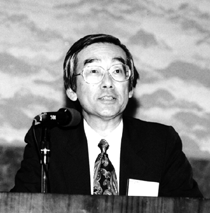
Yoichi Muraoka
ProfessorSchool of Science and Engineering,
Waseda University

|
Yoichi MuraokaProfessorSchool of Science and Engineering, Waseda University |
Today, I will first outline my impressions of the RWC Project as an outsider, and then go on to describe my field of interest related to the project.
The subtitle is "A, D & G" (Fig. 1).
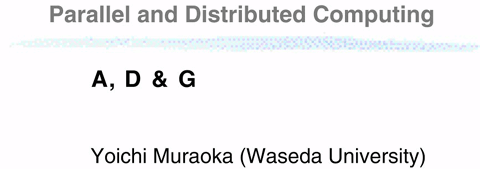
I believe and hope that national projects including RWC Project should satisfy the following three aspects (Fig. 2).
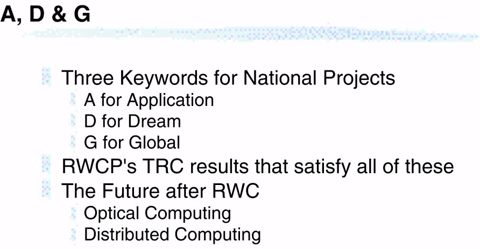
First, they should lead to new application fields. Hence, A for Application. I hope that completed technologies lead to new applications. Second, D for Dream. Technologies should pave the way for actualizing dreams. I sometimes wonder if there are still any dreams out there these days, but anyway, technologies should encourage dreams. Finally, they should be global. The word "global" has many meanings, and in this case it means that the results are considered globally useful. Also, global in the sense of global cooperation and global collaboration. In short, national projects should be magnanimous in cooperating on a global scale. These are the hopes from one tax-payer.
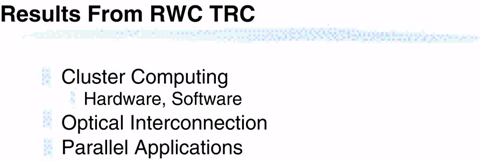
From these perspectives, the Tsukuba Research Center (TRC), which I visit often, is doing a great job, and I'll give some specific examples later. And I'll also talk about my project and research interests after this RWC Project at the end of my speech, which are mainly optical computing and distributed computing.
The results from TRC will be described in detail this afternoon, though we've already had an outline from Dr. Shimada, Director of Research Institute, RWCP. But let's review them briefly (Fig. 3). The results can be divided into three fields: Hardware and software for cluster computing, optical interconnection, and parallel applications. Note that those OHPs I use in the first part were kindly supplied by TRC members. RWC's PC Cluster was exhibited at SC97 (Fig. 4) as explained later.
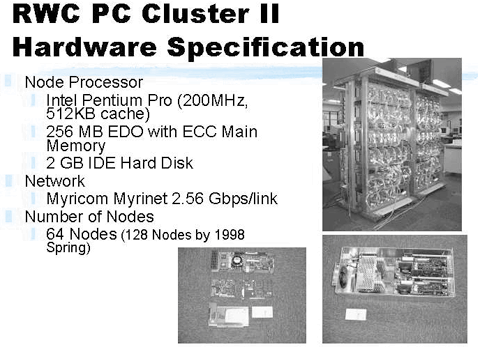
Although I did not have a chance to visit SC97, I watched a video of interviews with well-known researchers from around the world about this. These world-class researchers, some of whom I know, all praise this cluster approach as a truly useful, practical, and advanced accomplishment. As the previous speaker said, the video is being shown at this site, so please take a look if you're interested.
I myself have studied parallel compilers, so let's start with compilers. Compilers are hard to make for particular computers, and even more so for a wide range of environments including recently-emerging shared memory, distributed memory, and distributed systems. Nevertheless, RWC TRC has completed a superb platform for this (Fig. 5).
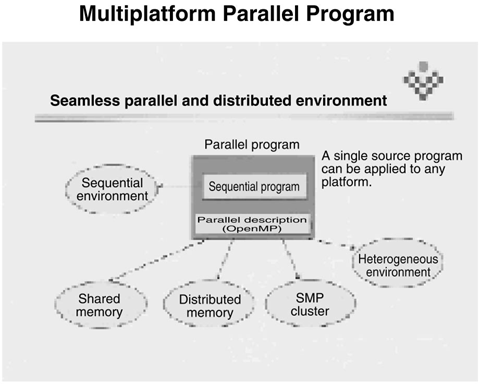
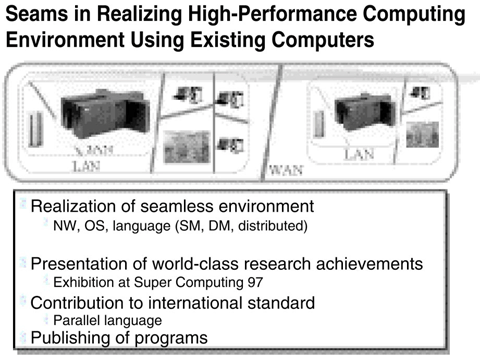
The goal is to create a seamless environment (Fig. 6), and the world-class achievements involving all networks, OSs, and languages were recognized as useful at SC97. Of course, SC97 is where only the best in the world exhibit their results, so if some result is not recognized there, then it's worth almost nothing, but if it is recognized, then it must be world-class. The parallel language and other research items have also been recognized as world-class in the international arena. I always preach, from my safe position as an outsider, that any national project, even though funded by the government and therefore subject to some legal restrictions, should always make its results available to the USA. And if that made Japan happy, then at least I would be happy too as a tax payer. Although I don't know much about government policy, it is what I always feel and express publicly. It might be going too far to claim that something that's useful only in Japan is worthless, but there is some truth in it. Having come this far, globalization can be attained by making our results publicly available to the whole world I know, of course, that not only TRC but also MITI and other agencies have their own policy. Programs are now published via the Internet, which is not limited to within Japan, although there are intranets within companies in the world of the Web. So I hope that not only programs but also research results will be published on a global scale.
Next, let's consider optical interconnection (Fig. 7).

It may sound immodest, but I would say that although optical interconnection has been advocated many times as being the best, even before the RWC Project was started, there have been no clear and explicit implementations. But this has now changed, with 1 Gbps this year (1998) and 5-10 Gbps by 2000, and so optical interconnection will soon be freely available to my delight. Again, optical interconnection should not be limited within Japan, only used to connect computers in Japan, but should be made available to connect computers throughout the world. For this, not only the technologies but also the specifications of many things, including the shape of connectors, should be made public to serve as a world standard.
Finally, applications. Applications are important in any and every field, especially in the world of computers and networks. If there were no applications, computers and networks would be useless. In this sense, PAPIA System, a protein structure analysis program, is a great achievement (Fig. 8).
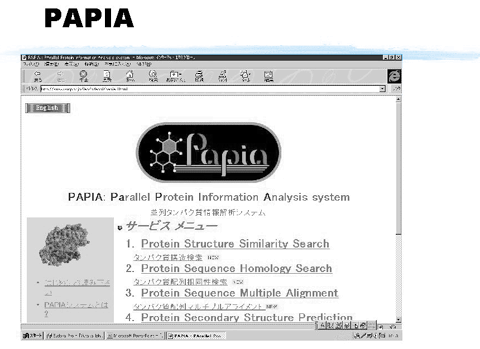
This figure is a copy I took of TRC's website, which might infringe their copyright and I ask them to allow me to use it here, to show PAPIA which has been made publicly available. Although I'm not in a position to judge the extent to which the results of Japanese national projects will be made available to other countries, I am still quite impressed and pleased that they've already published the results to the world.
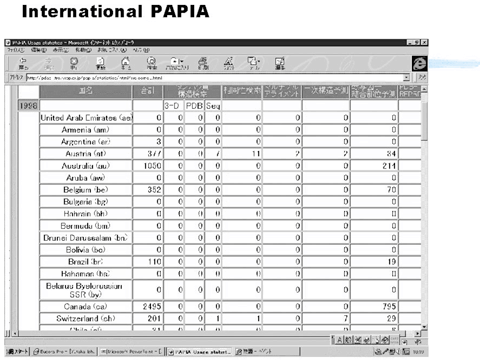
Fig. 9 is another copy I made from PAPIA's website, which I recommend you to visit, showing the number of hits from all around the world: 1000 hits from Australia, thousands from Canada, 200 from Switzerland, and many from the USA, in addition to the many hits from Japan. This trend should be continued, and new results should be published on the website. But yesterday, to my regret, I received a message saying "Not Available Today" when I tried to access the site.
With all of these, I'd like to express my sincere appreciation to RWC TRC, who have realized my somewhat naive hope that national projects or big projects should serve as a means for opening up new applications, opening up dreams, and publicizing the results worldwide.
Next, I'd like to describe my wish for the future in and after the RWC Project. Of course, if there are 100 people, there will be 100 different dreams, but please allow me to express my own hope. One of my dreams is optical computing, and the other is distributed computing (Fig. 10).

As I said earlier, optical computing has been advocated for so long without any implementation, but now implementations are emerging (Fig. 11). But interconnection alone is not enough; logic is also required. As you might know, the USA is working on the Petaflop Computing Project. To create petaflop machines, optical technology is a natural choice, but when will such machines emerge? The US Petaflop Machine Project has set one milestone in 2010, which embraces optical computing from interconnection to logic. My own dream is that optical technology involves not only digital but also analog, and if such multimodal optical computing systems are built, new applications would emerge.
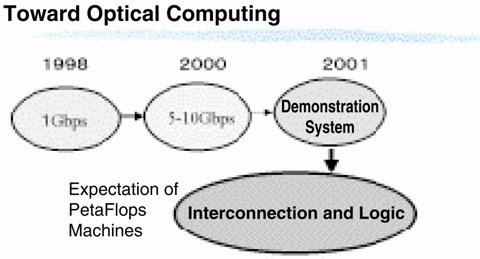
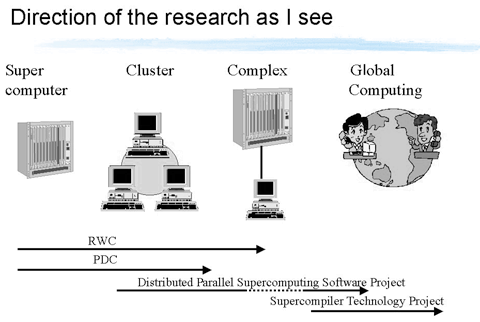
The next is distributed computing (Fig. 12), which of course involves many levels, from clusters developed by TRC to complex machines and networks on a global scale. RWC, then PDC, which is led by the previous speaker, Prof. Tanaka, and the plan for the second term for one of the priority area researches, were completed a couple of years ago. While many researches have been conducted, from clusters to complex networks, it is time to focus on global computing and distributed computing. Currently, the USA has a network computing project called NCSA which is mainly run at NCSA of the University of Illinois. This project is generally known as Alliance or PACI. Briefly, this project is designed to encourage new applications by connecting high-speed computers via high-speed computer networks (Fig. 13).
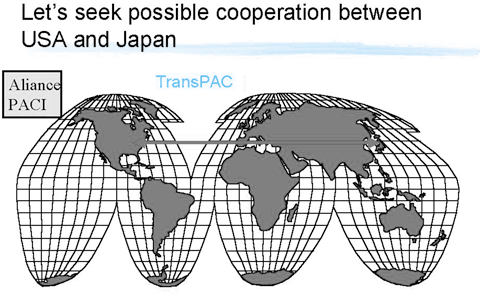
Along with such projects, Transpac, a network for researches connecting Japan and the USA, will soon be available this summer. Many research groups have joined this Transpac, so finally I'd like to express my dream for next-generation computing using Transpac.
I suggest three directions (Fig. 14):
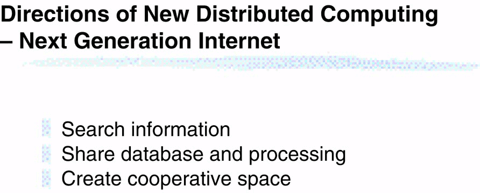
(1) Direction to "search information", (2) Direction to "share database and processing", and (3) Direction to "create cooperative space".
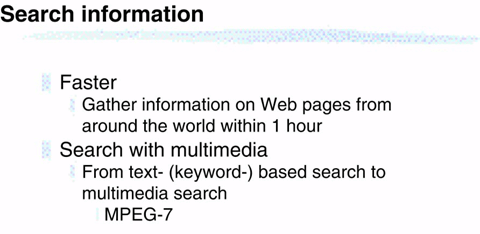
First, information search (Fig. 15) on the Web. For this, there are at least two steps. One is to gather information faster. As you know, search robots can be used to gather information, but it takes several months for them to gather information from all of Japan, so how long does it take to gather information from the whole world? It is necessary to be able to gather information from the whole world within one hour. As you see, the world changes rapidly: links which existed yesterday are gone today, and information that was not available yesterday is available today. The other is related to multimedia information, which is replacing text-based links. As the world of the Web moves to multimedia, text-based searches should move to multimedia searches.
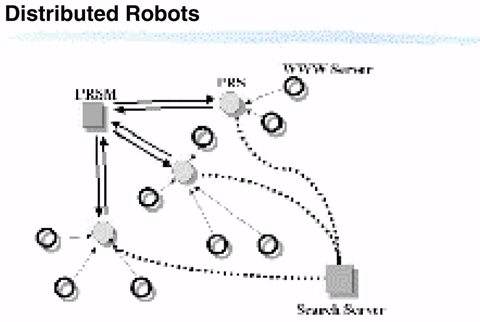
When using distributed robots (Fig. 16), it is naturally parallel processing in the sense in that many of them are used concurrently to speed up the search. For instance, The University of Kyoto, Waseda University, ETL, and University of Tokyo are now conducting experiments to gather information from all of Japan from their respective sites (Fig. 17). Univ. of Kyoto takes 600 hrs. (approx. 200+ days) and Univ. of Tokyo takes 400 hrs., which indicates the difference in status of their respective networks. This difference translates to 1:9.7 (approx. 1:10) in this experiment. The reason why non-linearity improves the speed is due to the effects of the networks. These organizations have their own turf or different locations close to their respective networks, and so searches can be made faster by exploiting the turf. For instance, Waseda University is now far from WIDE. Each organization has its advantages and disadvantages. To do it within one hour, a rough calculation indicates that some 50 robots should be distributed throughout Japan. Therefore, experiments are to be started by the end of this year with this configuration.
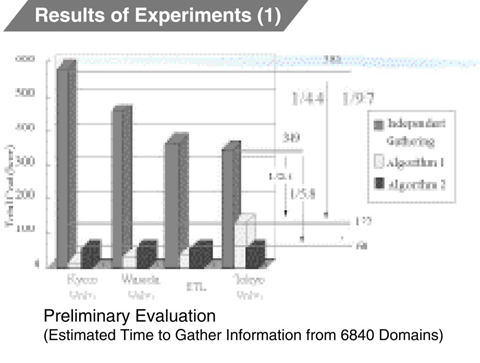
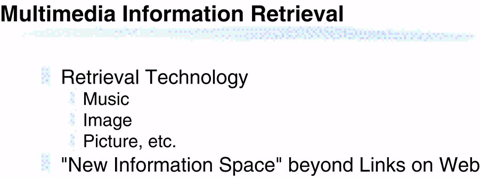
For multimedia searches (Fig. 18), since there is a lot of music, images, and pictures, as well as texts on the Web, we should create a new information space beyond links on the Web. To accomplish this, we need to develop multimedia information retrieval.

Fig. 19 shows one such example, where students of our university are searching for music (karaoke) by humming songs, and the appropriate songs are then retrieved with a correct retrieval rate of 99% (Fig. 20).
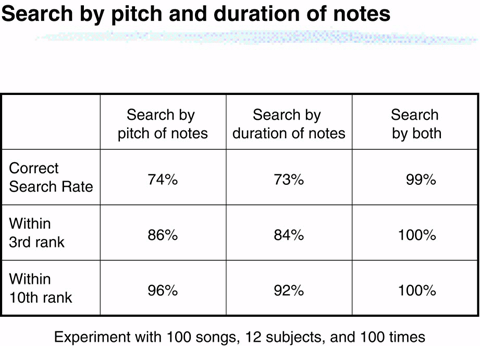
I don't know if anyone was singing out of key among the 12 subjects, but hopefully not.
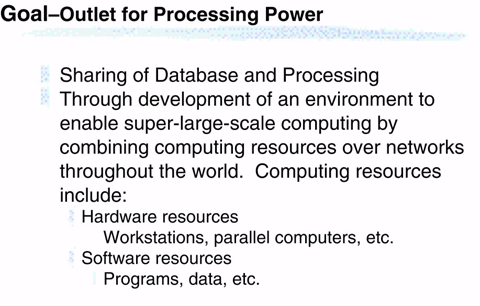
Second, the sharing of databases and processing (Fig. 21). Currently, distributed computing over networks is used to do many things, including Web computing. In this, when accessing the Web, applets are sent back, which in turn steal or borrow computing power in many places. However, the good point about distributed computing over networks is that, besides borrowing computing power, we can borrow databases, too (Fig. 22). For instance, there is a controversial book titled "Declaration of War", which describes what would happen if a nuclear plant broke down. Naturally, it would cause air pollution. To simulate it, weather information, status of the nuclear plant, and much other information are required. These pieces of information are located in different places: weather information is at the Meteorological Agency and information about nuclear plants is at a different location. This example may not be a good one because it involves national security. If, for instance, there were some mechanism to provide data at different locations in a desired form, we would be able to simulate or study weather information any time we wanted to. The goal of the second subject is to create such mechanisms.
The last one is distributed collaborative space (Fig. 23).
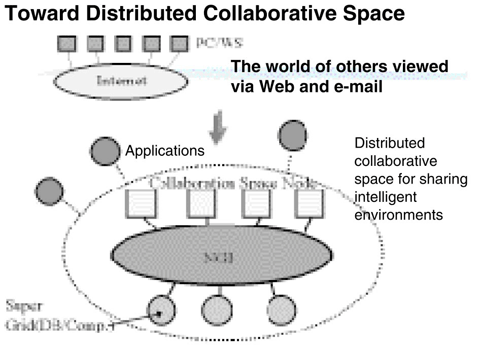
The current network world can only be viewed through a tiny window via Web and e-mail. We simply want to share the environments. Recently, TV cameras are being set up at street corners and the images captured by them are then broadcast over the Internet. I've heard that there are about 4,000 such cameras in the world, which shocked me. I don't want to be seen by others while walking with a vacant look. Anyway, sharing space is becoming a reality. What if we push it further? For instance, regardless of where we actually are, we can be in the same laboratory, or we have the same environment for our jobs. This could lead to new terminal environments where conventional terminals become simply screens, rooms, or open spaces, or rather space environments, which in turn can be linked together to form a collaborative space. Fig. 24 shows virtual reality cable system. These screens look like books, and you can imagine many pleasant applications (Fig. 25).
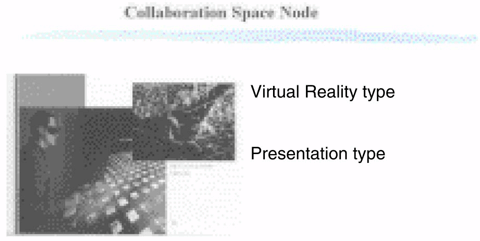
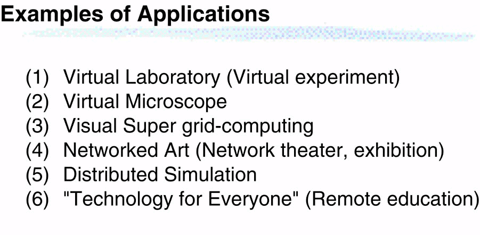
Collaborative space is where people work together, such as a virtual laboratory, network theater, and distributed simulation. It is not only for discussing together, but also for working together.
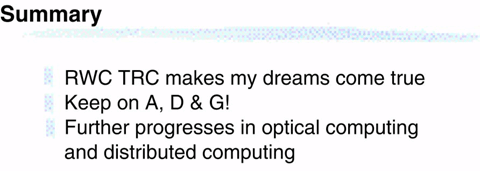
To summarize (Fig. 26), I thank the RWC, especially TRC, for making my dreams of A, D, and G come true. I hope many such projects will appear.
To conclude, although I'm slightly biased, I'm particularly interested in optical computing and distributed computing.